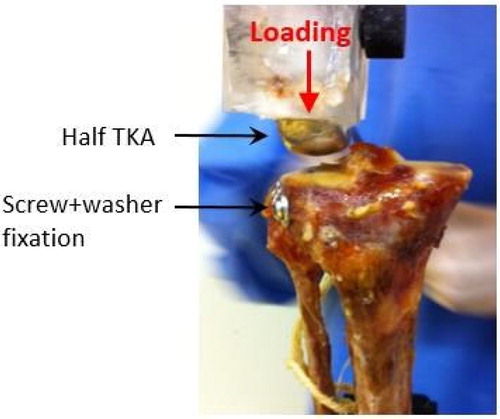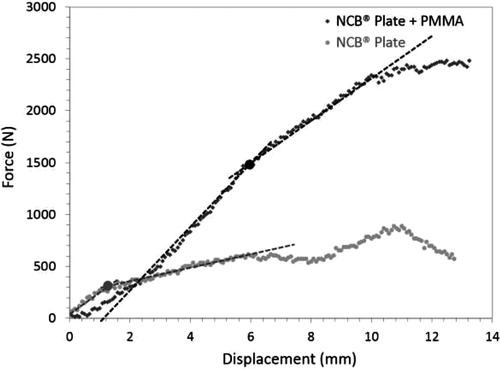1. Introduction
The most frequent tibial plateau fractures are known as ‘depression-separation’ in the Duparc and Ficat classification (Duparc and Ficat Citation1960) or type 2 in the Schatzker classification (Schatzker et al. Citation1979).
The choice of different types of osteosynthesis remains at the surgeon’s discretion for this type of fracture. Surgical treatment is commonly accepted for these fractures and there is a strong trend towards an increase in minimally invasive treatment.
The objective of this surgery is to have the best reduction associated to the best stabilization so that early passive and active reduction can be achieved to avoid stiffening and muscle loss. The objective is also an early loading for a quick function recovery. The use of a reduction balloon allows the use of injectable filling. These fillings can be based on phosphocalcic or PolyMethylMethAcrylate (PMMA) nature.
PMMA is the injectable filler offering the highest mechanical properties in compression. It is very regularly used in orthopaedic surgery for filling in vertebral fractures or for arthroplasty. The objective of this study was to define the contribution of a PMMA filling with the different types of modern percutaneous synthesis with orientable screws in case of tibial plateau fractures (Schatzker 2). The comparison criteria were mechanical strength according to depression displacement.
2. Methods
2.1. Specimen preparation
Schatzker 2 fractures were created on 36 human freshfrozen tibiae and reduced with a balloon by a minimally invasive approach: Tuberoplasty (Vendeuvre et al. Citation2013, Citation2018). Specimens were distributed in three groups corresponding to three different types of synthesis: one group by two 4.5 mm bicortical screws; one group by direct locking plates VA-LCP (Synthes) and one group by secondary locking caps NCB (Zimmer). Each group of synthesis was divided in two subgroups of six specimens: one subgroup with PMMA HVR (Medtronic) filling and one subgroup without cement.
Finally, six groups were compared.
2.2. Mechanical analysis
A half Total Knee Arthroplasty (h-TKA, Zimmer Unicompartimental Knee High Flex®, 48 mm) positioned on the Tinius Olsen® (10 kN) compression machine, and placed over the external tibial plateau (), applied a compression loading up to damage. Loading speed was set at 5 mm/min. A load sensor (10 kN) located on the actuator of the compression machine and its displacement provided the measurements during the loading to characterize mechanical behaviour for each specimen.
Thanks to the boundary conditions, we studied the depression displacement and the force value necessary to produce a non-linear mechanical response of the upper tibial extremity. This latter factor was used to characterize assembly failure.
2.3. Statistical analysis
Quantitative variables were summarized using the mean and standard deviation while qualitative variables were summarized using counts and percentages. t-test was used to compare the linear limit for depression between the two groups (with/without cement). One way ANOVA was used to compare the linear limit for depression different types of ostheosynthesis. A two-way ANOVA was used to test the effect of both cement and the type of ostheosynthsis and their interaction compare to the linear limit for depression. Tuckey’s test procedure for multiple testing was used to conduct multiple comparisons between the different groups.
3. Results and discussion
To illustrate loading-displacement curves, shows evolutions of force vs displacement for two specimens stabilized with plates and with or without PMMA. Values of the linear limit force for each group are given in .
Table 1. Mean and Standard Deviation (SD) force values at linear limit for the three syntheses with or without PMMA.
Concerning depression there is a significant difference between cementless syntheses and syntheses with cement (difference 507.56 N 95% confidence interval [110.94N, 904.17 N] p-value = 0.026). The differences between the different types of synthesis are not significant (p-value = 0.58).
An analysis by a 2 factor ANOVA shows that only the addition of cement has an influence on depression (p = 0.013) and that neither the type of synthesis nor the interaction between the type of synthesis (p = 0.43) and the cement influences depression (p = 0.82).
4. Conclusions
We wanted to understand the influence of a PMMA type filling in association with different osteosynthesis. We can see that only the association with PMMA significantly increases the resistance. This study compared the stability of screws or plates that can be used minimally invasively in addition to balloon reduction. These types of osteosynthesis have been selected because they all respond to the fact that the screws are adjustable and can therefore be optimally positioned under the depression. The choice of the two different plates was made in order to compare a direct locking mode in the plate by the screw head (VA-LCP) and another secondary one by cap (NCB).
The choice of synthesis is therefore at the surgeon’s discretion according to the type of fracture Schatzker 2.
PMMA significantly increases, regardless of the type of osteosynthesis, the primary stability of the depression assembly.
References
- Duparc J, Ficat P. 1960. Articular fractures of the upper end of the tibia. Rev Chir Orthopédique Réparatrice Appar Mot. 46:399.
- Schatzker J, Mcbroom R, Bruce D. 1979. The Tibial plateau fracture: the Toronto experience 1968–1975. Clin Orthop. 138:94–104.
- Vendeuvre T, Babusiaux D, Breque C, Khiami F, Steiger V, Merienne J-F, Scepi M, Gayet LE. 2013. Tuberoplasty: Minimally invasive osteosynthesis technique for tibial plateau fractures. Orthop Traumatol Surg Res. 99(4):S267–S272.
- Vendeuvre T, Grunberg M, Germaneau A, Maloubier F, Faure J-P, Gayet L-E, Rigoard P, Breque C. 2018. Contribution of minimally invasive bone augmentation to primary stabilization of the osteosynthesis of Schatzker type II tibial plateau fractures: Balloon vs bone tamp. Clin Biomech. 59:27–33.


